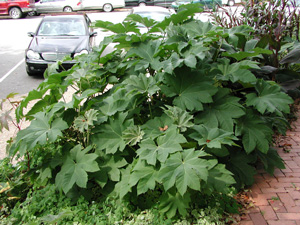Resource Library
Plant of the Week: Rice Paper Plant
The University of Arkansas System Division of Agriculture does not promote, support or recommend plants featured in "Plant of the Week." Please consult your local Extension office for plants suitable for your region.
Plant of the Week
Rice Paper Plant
Latin: Tetrapanax papyrifer

Big, bold and beautiful has become a popular theme in gardening, especially in shade gardens, where oversized leaves produce a tropical look during the swelter of an Arkansas summer. Many plants can be used to provide the effect, but few are as spectacular as the rice paper plant, Tetrapanax papyrifer.
Rice paper plant is a monotypic frost-tender small tree or large shrub of southern China and Taiwan. It belongs to the aralia family and has a growth habit similar to our native devil's walking stick (Aralia spinosa), except Tetrapanax does not have spines on its trunks. In its native range, it produces a tree to 15 feet tall that spreads sideways by means of widespreading underground rhizomes, which can produce a thicket 20 to 30 feet across. Stems are frost-tender and will be killed when temperatures fall below 20 degrees Fahrenheit, but the roots are hardy and will survive as long as the ground does not freeze hard and deep.
In temperate gardens, rice paper plant is known only as a giant-leafed perennial with deeply cut castor bean-shaped leaves that may be as much as 2 feet across. Petioles are usually as long as the leaf blade. These large leaves are a juvenile characteristic enforced by the annual freezing back to the ground. If the trunks do not freeze back annually and the plant attains flowering size, the leaves will be about half as large.
Flowers do not appear in temperate gardens because they are only produced from the ends of aboveground branches. In mild sections, the white flowers appear in early summer as wooly balls in a large, multiple-branched panicle held above the foliage. If pollination occurs, the berries will be purple and about the size of a pea.
Rice paper plant gets its name from early confusion by European botanists about the source of the plant used to make rice paper. Rice straw is used for most rice paper, but the inner bark of mulberry and elm are used for high-quality writing rice paper. The pith of Tetrapanx is used as a thin veneer, much as veneers are cut from pine logs to make plywood. These rice paper veneer sheets are dried and can be used for bold calligraphy or, more commonly, to make artificial flowers. Stems can reach 4 inches in diameter, with the pith consisting of a large part of the stem cross section. The pith is also used as a part of the traditional Chinese pharmacopeia (where it is known as tong cao) and is recommended for urinary tract disorders, amongst others.
Rice paper plant is root-hardy from zones 7 through 10 and top hardy in zone 9. In colder areas, it is used in light shade or full sun in the border, where the bold leaves give the setting a tropical look. It is best in a rich, moist soil, but in such a good soil its rhizomes will be more aggressive and spread further. All gardeners who successfully grow rice paper plant comment on the fact it produces runners and will pop up 10 or 15 feet away from the original plant. These new plants are easily removed and relocated, given away or discarded. Mulching in cold climates will reduce the likelihood of the soil freezing and losing the plant.
The devil's walking stick I planted near my privacy fence in my shade garden a decade ago shares rice paper plant's tendency to spread by underground rhizomes. Every year I cut off a couple of unwanted shoots from the devil's walking stick as they emerge and have been able to maintain the plant as a single-stemmed tree. My neighbor, a non-gardener who seldom ventures into his unmaintained woodland, now has a small thicket of plants adorning his hillside. The moral - runners are easy to control, but if allowed to grow unchecked, the plant can spread to areas not originally intended.
By: Gerald Klingaman, retired
Retired Extension Horticulturist - Ornamentals
Extension News - June 24, 2011
The University of Arkansas System Division of Agriculture does not maintain lists of retail outlets where these plants can be purchased. Please check your local nursery or other retail outlets to ask about the availability of these plants for your growing area.